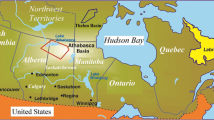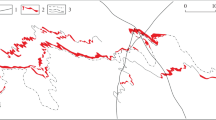Abstract
Uranium deposits in sedimentary basins can be formed at various depths, from near surface to the basement. While many factors may have played a role in controlling the location of mineralization, examination of various examples in the world, coupled with numerical modeling of fluid flow, indicates that the hydrodynamic regime of a basin may have exerted a major control on the localization of uranium deposits. If a basin is strongly overpressured, due to rapid sedimentation, abundance of low-permeability sediments or generation of hydrocarbons, fluid flow is dominantly upward and uranium mineralization is likely limited at shallow depths. If a basin is moderately overpressured, upward moving fluids carrying reducing agents may meet downward moving, oxidizing, uranium-bearing fluids in the middle of the basin, forming uranium deposits at moderate depths. If a basin is weakly or not overpressured, either due to slow sedimentation or dominance of high-permeability lithologies, minor topographic disturbance or density variation may drive oxidizing fluids to the bottom of the basin, leaching uranium either from the basin or the basement, forming unconformity-type uranium deposits. It is therefore important to analyze the hydrodynamic regime of a basin in order to predict the most likely type and location of uranium deposits in the basin.
Similar content being viewed by others
References
Alexandre P, Kyser K, Polito P, et al. 2005. Alteration mineralogy and stable isotope geochemistry of Paleoproterozoic basement-hosted unconformity-type uranium deposits in the Athabasca Basin, Canada. Econ Geol, 100: 1547–1563
Bethke C M, Lee M K, Quinodoz H, et al. 1993. Basin modeling with Basin2, a Guide to using Basin2, B2plot, B2video, and B2view. Urbana: University of Illinois. 225
Bethke C M. 1985. A numerical model of compaction-driven groundwater flow and heat transfer and its application to paleohydrology of intracratonic sedimentary basins. J Geophys Res, 90: 6817–6828
Bykadorov V A, Bush V A, Fedorenko O A, et al. 2003. Ordovician-Permian palaeogeography of Central Eurasia: Development of Palaeozoic petroleum-bearing basins. J Petrl Geol, 26: 325–350
Chi G, Bosman S, Card C. 2011. Fluid flow models related to uranium mineralization in the Athabasca basin: A review and new insights. Saskatchewan Geological Survey Open House, Abstract Volume. 4
Chi G, Bosman S, Card C. 2013. Numerical modeling of fluid pressure regime in the Athabasca basin and implications for fluid flow models related to the unconformity-type uranium mineralization. J Geochem Explor, 125: 8–19
Chi G, Savard M M. 1998. Basinal fluid flow models related to Zn-Pb mineralization in the southern margin of the Maritimes Basin, eastern Canada. Econ Geol, 93: 896–910
Cui T, Yang J, Samson I M. 2012. Tectonic deformation and fluid flow: Implications for the formation of unconformity-related uranium deposits. Econ Geol, 107: 147–163
Cuney M. 2010. Evolution of uranium fractionation processes through time: Driving the secular variation of uranium deposit types. Econ Geol, 105: 553–569
Dahlkamp F J. 2009. Typology of Uranium Deposits, Uranium Deposits of the World-Part I. Heidelberg: Springer-Verlag. 1–24
Finch W I. 1996. Uranium provinces of North America-their definition, distribution, and models. U.S. Geol Survey Bull, 2141: 1–18
Fisher R P. 1970. Similarities, differences, and some genetic problems of the Wyoming and Colorado Plateau types of uranium deposits in sandstone. Econ Geol, 65: 778–784
Fyodorov G V. 1999. Uranium deposits of the Inkay-Mynkuduk ore field, Kazakhstan. In: Developments in Uranium Resources, Production, Demand and the Environment. Proceedings of International Atomic Energy Agency Technical Meeting. Vienna. IAEA-TECDOC-1425, 95–112
Harrison W J, Summa L L. 1991. Paleohydrogeology of the Gulf of Mexico basin. Am J Sci, 291: 109–176
Hecht L, Cuney M. 2000. Hydrothermal alteration of monazite in the Precambrian basement of the Athabasca Basin: Implications for the genesis of unconformity related deposits. Mineral Deposit, 35: 791–795
Jaireth S, McKay A, Lambert I. 2008. Association of large sandstone uranium deposits with hydrocarbons. AUSGEO News, 89: 1–6
Jefferson C W, Thomas D J, Gandhi S S, et al. 2007. Unconformity-associated uranium deposits of the Athabasca Basin, Saskatchewan and Alberta. In: Jefferson C W, Delaney G, eds. EXTECH IV: Geology and Uranium Exploration Technology of the Proterozoic Athabasca Basin, Saskatchewan and Alberta. Geol Surv Can Bull, 588: 23–67
Kyser T K, Cuney M. 2008a. Introduction. In: Cuney M, Kyser T K, eds. Recent and Not-so-recent Developments in Uranium Deposits and Implications for Exploration. Mineral Ass Canada Short Course Series, 39: 1–14
Kyser T K, Cuney M. 2008b. Unconformity-related uranium deposits. In: Cuney M, Kyser T K, eds. Recent and Not-so-recent Developments in Uranium Deposits and Implications for Exploration. Mineral Ass Canada Short Course Series, 39: 161–220
Kyser T K, Cuney M. 2008c. Sandstone-hosted uranium deposits. In: Cuney M, Kyser T K, eds. Recent and Not-so-recent Developments in Uranium Deposits and Implications for Exploration. Mineral Ass Canada Short Course Series, 39: 221–240
Kyser T K, Hiatt E, Renac C, et al. 2000. Diagenetic fluids in Paleo- and Meso-Proterozoic sedimentary basins and their implications for long protracted fluid histories. In: Kyser T K, ed. Fluid and Basin Evolution. Mineral Ass Canada Short Course, 28: 225–262
Kyser T K. 2007. Fluids, basin analysis, and mineral deposits. Geofluids, 7: 238–257
Ling M. 2007. Mineralogical and geochemical studies of sandstone-type uranium mineral deposits in the Ordos Basin (in Chinese). Ph.D. Thesis. Hefei: China University of Science and Technology
Mikhailov V V, Petrov N N. 1998. Age of exogene uranium deposits in south and south-east Kazakhstan according to the lead-isotope study. Geol Kazakhstan, 2: 63–70
Nash J T, Granger H C, Adams S S. 1981. Geology and concepts of genesis of important types of uranium deposits. Econom Geol, 75: 63–116
Northrop H R, Goldhaber M B. 1990. Genesis of the tabular-type vanadium-uranium deposits of the Henry Basin, Utah. Econ Geol, 85: 215–269
Pagel M, Poty B, Sheppard S M F. 1980. Contributions to some Saskatchewan uranium deposits mainly from fluid inclusion and isotopic data. In: Fergusom S, Goleby A, eds. Uranium in the Pin Creek Geosyncline. Int Atomic Energy Agency, 639–655
Raffensperger J P, Garven G. 1995a. The formation of unconformity type uranium ore deposits: 1. Coupled groundwater flow and heat transport modeling. Am J Sci, 295: 581–636
Raffensperger J P, Garven G. 1995b. The formation of unconformity type uranium ore deposits: 2. Coupled hydrochemical modeling. Am J Sci, 295: 639–696
Ren Z, Zhang S, Gao S. et al. 2006. Relationship between thermal evolution and various energy and mineral resources in the Dongsheng area, Yimeng uplift (in Chinese). Oil Gas Geol, 27: 187–193
Reynolds R L, Goldhaber M B. 1983. Iron disulfide minerals and the genesis of roll-type uranium deposits. Econ Geol, 78: 105–120
Sanford R F. 1992. A new model for tabular-type uranium deposits. Econ Geol, 87: 2041–2055
Sibson R H, Robert F, Poulsen K H. 1988. High-angle reverse faults, fluid-pressure cycling, and mesothermal gold-quartz deposits. Geology, 16: 551–555
Spirakis C S. 1996. The roles of organic matter in the formation of uranium deposits in sedimentary rocks. Ore Geol Rev, 11: 53–69
Wei Y, Wang Y. 2004. Comparison of enrichment patterns of various energy and mineral resources in the Ordos Basin (in Chinese). Oil Gas Geol, 25: 385–392
Xia Y, Lin J, Liu H. 2003. Geochronological studies of sandstone-type uranium deposits in major uranium-producing basins in northern China (in Chinese). Uranium Geol, 19: 129–136
Xue C, Chi G, Xue W. 2011. Effects of hydrocarbon generation on fluid flow in the Ordos Basin and relationship with uranium mineralization. Geosci Front, 2: 439–447
Xue C, Chi G, Xue W. 2010. Interaction of two fluid systems in the formation of sandstone-hosted uranium deposits in the Ordos Basin: Geochemical evidence and hydrodynamic modeling. J Geochem Explor, 106: 226–235
Author information
Authors and Affiliations
Corresponding author
Rights and permissions
About this article
Cite this article
Chi, G., Xue, C. Hydrodynamic regime as a major control on localization of uranium mineralization in sedimentary basins. Sci. China Earth Sci. 57, 2928–2933 (2014). https://doi.org/10.1007/s11430-014-4976-3
Received:
Accepted:
Published:
Issue Date:
DOI: https://doi.org/10.1007/s11430-014-4976-3




